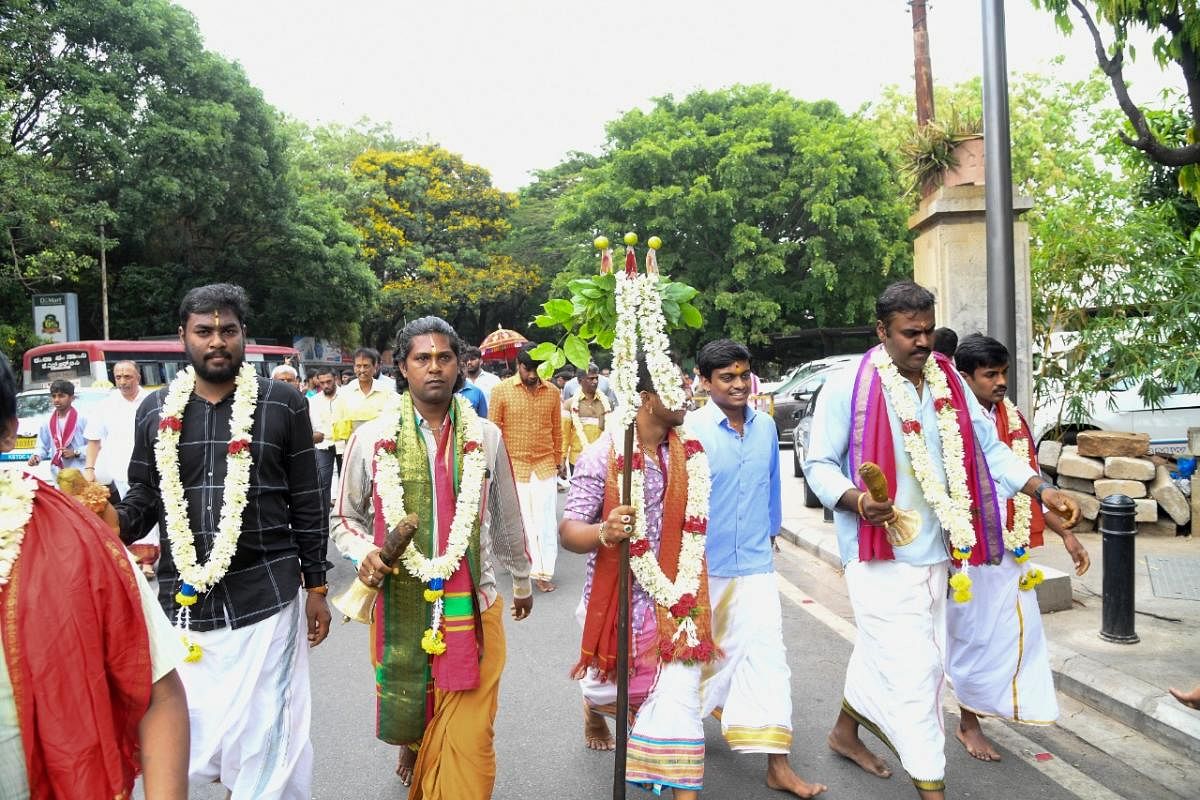

In her 2001 book ‘Landscapes Of Urban Memory: The Sacred and the Civic in India’s High-Tech City’, Smriti Srinivas writes about the specificity of Bengaluru Karaga, which is among the two oldest festivals of the city, the other being a groundnut fair, Kadlekai Parishe. Some say it is over 400 years old, others, over 800 years. It owes its specificity to a “constellation” of factors, pivoted on the cult of Draupadi and her hero-sons, Sufism in the region, and urbanism, she writes.
As this article goes into print in the small hours of April 16 (Saturday), the 11-day festival enters Day 9 with an extravagant procession that lasts till sunrise. Six lakh people are expected to participate in it this year. In pre-Covid times, people travelled from many parts of south India to watch the fete, held to mark the return of Draupadi, whose story is told in the epic ‘Mahabharata’, on earth once a year.
With the scent of camphor and jasmine in the air, and accompanied by the sounds of the drums and the conch, people stand around, waiting to see Draupadi, their ‘amma’. Wearing a golden headgear and ‘purity wristband’, Veerakumaras, ‘hero-sons’ of Draupadi, walk for 18 to 20 km through old Pete areas, halting at Hazrat Tawakkal Mastan Dargah as part of a long custom, wielding swords and guarding the priest who dances as he balances a ‘karaga’ on his head without touching it.
Karaga is a floral pyramid resting on a mud pot, symbolic of Draupadi. Interpreting the word, some say, ‘ka’ means without using hands, ‘ra’ means balancing on the head, and ‘ga’ means moving. The floral pyramid weighs 15 to 20 kilos. It requires the priest carrying it to build his physical stamina in a local garadi mane (Kannada for wrestling house) for six months.
The festival is celebrated by Vahnikula Kshatriyas, also called Thigalas, a Tamil-speaking community of horticulturists. In course of time, it came to be a more broad-based festival, embracing all communities.
“Because of the Deccan Sultanate and the Persianisation of culture, there was a change in the lifestyle of the ruling class. They wanted gardens and skilled people to create them. This caused a big migration of Thigalas from north Tamil Nadu to Bangalore in the 17th century,” a historian says, wishing not to be named. So flowers became a big part of rituals, he says. Mostly jasmine. Suresh Moona, an expert on Bengaluru’s history, shares what he was told by an elderly Thigala: “Jasmine flowers have a strong scent. It helps the priest focus as he dances while balancing the karaga on his head.”
Oral histories are open to interpretation and so is the Karaga. It is held during Chaitra, the first month in the Hindu calendar, just after the harvesting season. “After the harvest, sometimes land becomes barren. I think Karaga is a cult related to invoking fertility,” the historian says. Likewise, Anusha Pullaiah, a 23-year-old political researcher and a Thigala, says it is a worship of different elements of nature. “We go from one lake to another for puja,” she says. All lakes and parks where the Thigalas offer worship, now staggered across a busy commercial district, are on lands they once owned or cultivated, many in the community claim.
The festival is also an exercise in gender fluidity. The Karaga priest dresses up in a sari, borrowing his wife’s mangalsutra and bangles and performing a hypnotic dance till he is transformed into Draupadi. At this point, it is difficult to overlook that a festival in honour of Draupadi, a woman of power, neither has a female Karaga carrier nor women’s participation in all rituals.
Many justifications are given: The pot is heavy for women to carry; menstruating women are impure for rituals; the crowding makes it unsafe for women. Devendra, an elderly Thigala, argues women do play a role: “They are present even during the goat sacrificing ritual.” Anusha sees sociological value in the way the festival plays out: “To see so many thousands of men worship a woman is inspiring and empowering.”